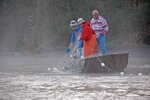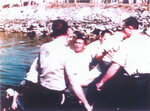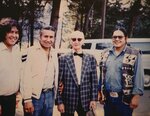


, Billy Jr & Willie Frank (103).tif.jpg)
In the aftermath of the Boldt Decision, there were furious protests from both sports fishermen and those in the salmon fishing industry. The State of Washington was now required to manage its fisheries to ensure that 20 Western Washington tribes got their treaty-right 50% of the fish harvest, which would cut the non-Indians’ share.
These sport and commercial fishermen insisted that the Boldt decision meant Indians were getting special privileges they didn’t earn or deserve.
The non-Indian commercial salmon fishing fleet was violating state fishing regulations and seasons, intentionally overfishing the salmon to protest the decision (and also to fill their own pocketbooks). A citizen’s initiative was launched to stop the state from managing for Indian treaty-right fishing. It received sufficient signatures, and at the succeeding election it was approved by the voters.
The state’s political leadership was indifferent, if not hostile, to the judgment of the federal court. Attorney General Slade Gorton and the state fisheries agencies worked tirelessly to undermine the decision’s implementation, turning a blind eye to overfishing. Even the Washington State Supreme Court upheld the anti-treaty rights initiative, ordering the state agencies not to enforce its provisions and thus creating a state/federal conflict.
In 1977 Judge Boldt, in response to the state’s refusal to enforce his orders and even Washington’s own regulations, took the unusual step of taking over from the state salmon and steelhead harvest management (which essentially diminished the state government’s sovereignty). Washington citizens today likely are unaware that in 1977 and for some time thereafter, the federal court established salmon fishing regulations, and federal marshals enforced those regulations.
(This state defiance of the federal court and the deployment of federal marshals to enforce court orders paralleled the desegregation and voting rights struggles in the American South, where state governments defied federal school integration court orders, resulting in the deployment of federal marshals. However, as you will see, the two paths ultimately would diverge).
There was a blizzard of lawsuits during this period. One was filed by the non-Indian commercial fishing organizations against the State of Washington when it began to include treaty-right fishing in its annual harvest plans. The non-Indian fishers argued that such planning was illegal under state law. It was a thinly disguised attempt to put treaty-right fishing before the U.S. Supreme Court, and it succeeded. In 1979, under a case entitled Washington vs. Washington State Commercial Passenger Fishing Vessel, the Supreme Court upheld the Boldt Decision in all its major elements and even added additional language regarding the obligation of the federal government to manage the ocean salmon fisheries to provide for treaty-right harvests.
To help explain the complexities of salmon management I need to define some terms. Each salmon species returns to its natal river (the Nisqually River coho, for example), which in management terms is called its terminal area. Specific hatchery production is also called a specific salmon stock. The goal of conservation should be to provide adequate spawning escapement of each stock.
Pre-Boldt salmon harvest management by the state was oriented toward fishing in areas where the multiple salmon stocks were mixed, the ocean for example, and not to plan for harvests in terminal areas where conservation goals could be monitored. The state made allocations between various harvest gear types, which made up competing interest groups. These included:
The state and federal agencies operated a large network of hatcheries to increase the numbers of available salmon for harvest. Hatchery-origin stocks can sustain a harvest rate much higher than natural stocks. Management by watershed was unheard of; the state did not plan for what happens when the salmon return from saltwater to their natal rivers, the sites of the treaty-right Indian fisheries.
The state mandate prioritized salmon harvest allocated by multiple gear types, not conservation. Each tribe was oriented toward harvest of the salmon returning to its own home watershed. Thus the conservation burden fell upon tribal treaty-right fishing.
Post-Boldt, the state attempted to manage its harvests as usual. And, not surprisingly, throughout the late 1970s and into the early 1980s state agencies and tribal treaty fisheries were in more or less constant conflict, with regular appeals to the federal court. Judge Boldt, in response, in 1975 established the Fisheries Advisory Board (FAB), headed by an independent technical advisor. Boldt’s goal was to solve disputes out of court, or at least to receive an independent technical recommendation from the FAB.
The tribes, who lacked the scientific expertise of the state, responded in late 1974 by creating the Northwest Indian Fisheries Commission. The Commission initially had two assignments: outreach to tell the story of treaty-rights, and the hiring of an experienced technical staff to advise tribes on fisheries management. The Commission was, and still is, located in Olympia and it now provides a much wider variety of services to the 20 fishing-right tribes of Western Washington.
In 1977 something important happened locally with the Nisqually Tribe. Billy Frank, Jr., the face of the Indian Fish Wars, was elected to the Tribal Council and appointed as the tribe’s fisheries nanager. Billy developed a plan for the Nisqually Tribe’s fishery and a fisheries management team. (In 1978 Billy hired me to become the environmental management part of this team and that is why, 45+ years later, I am here to write these articles).
Soon Billy was elected to represent the Medicine Creek Treaty Tribes (Nisqually, Squaxin, and Puyallup) on the Northwest Indian Fisheries Commission and, shortly thereafter, he was elected as the Chairman of the Commission. Billy was the ideal person to have as the tribes’ spokesperson. He was tireless and charismatic, and he knew the issues well. He was held in great respect by other tribes and was allowed to speak for all, and he related well to both the public and elected officials.
Paraphrasing him, they were:
The 1979 U.S. Supreme Court decision had largely broken the back of the opposition to the Boldt Decision, so Billy’s message about cooperation was timely. After all, the six years of fighting didn’t solve any habitat problems or build any hatcheries. In the post-Boldt years “cooperation with Indian Tribes” had been cuss words. Little by little, cooperation emerged and one of its first steps occurred locally.
The Nisqually was the only major river on Puget Sound without a large hatchery. An ideal site had been identified on the Fort Lewis side of the Nisqually Indian Reservation, but no progress had been made toward developing that site. In 1980 Billy Frank, working with leaders of the Washington Department of Fisheries, negotiated a state/tribal fisheries management agreement.
The agreement, which pledged the parties to work together to develop a Nisqually hatchery, was signed by Governor Dixy Lee Ray and Tribal Chair Dorian Sanchez. As a result, Representative Norm Dicks arranged for funding of a hatchery feasibility study at the Fort Lewis Clear Creek site. The site certainly was feasible. The hatchery was federally funded, built in the 1980s, and dedicated in 1991. This hatchery releases 4 million Chinook smolts per year and the returning adults provide good fishing opportunities for both the Nisqually Tribal Fishermen and hook-and-line sports fishermen.
In Part 3 of this series, I will continue to relate the many benefits of the Boldt decision for fisheries, and overall natural resource management in the Pacific Northwest and locally.
George Walter, environmental program manager at the Nisqually Indian Tribe’s natural resources department, has worked for 45+ years in various elements of fisheries for the Tribe. He may be reached at george@theJOLTnews.com
7 comments on this item Please log in to comment by clicking here
kozicks
Don’t forget that White Europeans took land that didn't earn or deserve.
Friday, February 16 Report this
JudithB
Thank you for this excellent and important history lesson. Looking forward to future installments.
Saturday, February 17 Report this
pacificm
With all the concern these days regarding "immigrants" illegally entering "our country" and causing harm how interesting that we would forget that it is us whites who barged into this land and took it from people who were living here already. As if that wasn't enough, we brought black slaves to do our labor meanwhile feeling justified in our actions. One bizarre element in all this is that these were white Christians who felt that God granted special privileges to whites over those who were non-white even though the region that Jesus came from was dominated by people with darker skins. So, the question that is being skirted all along regarding these issues is reparations. What can whites do to compensate for these wrongs? The white fisherman shouldn't bear all the responsibility for reparations. However, the question in this situation is what is appropriate for all of us white invaders to share in reparations and land rights that are justly due?
Saturday, February 17 Report this
GinnyAnn
Thank you for a concise and thorough history of the Boldt Decision. I learned more from your story here than I knew before. I remember how difficult those times were for us in Washington state, as this issue was divisive and inflammatory. Rooting for the Indians could get you black balled among your friends. The world has benefitted by the conservation efforts of the tribal fisheries and environmental protections put into place to protect their rights. The fish have largely been saved from over-fishing by commercial harvesting, although we have a long way to go. I'm looking forward to part three of your story.
Saturday, February 17 Report this
Chloeandme
For a full picture of the Treaty Signing Event check out the book The Bitter Waters of Medicine Creek by Richard Kluger. A very eye opening and sobering story of Washington States official beginning and subsequent establishment at the cost of our local First Nations People. I am not Native American and found the story very humbling. The history should be included in all schools curriculum concerning Washington History.
Saturday, February 17 Report this
wildnature
Hooray for the Bolt decision and the Tribes!
Monday, February 19 Report this
HarveysMom
This story is important, for what it tells about the environment and about human history. Thank you George (and Billy Frank).
Tuesday, February 20 Report this